JEEP CHEROKEE 2015 KL / 5.G Owners Manual
Manufacturer: JEEP, Model Year: 2015, Model line: CHEROKEE, Model: JEEP CHEROKEE 2015 KL / 5.GPages: 772, PDF Size: 18.21 MB
Page 101 of 772
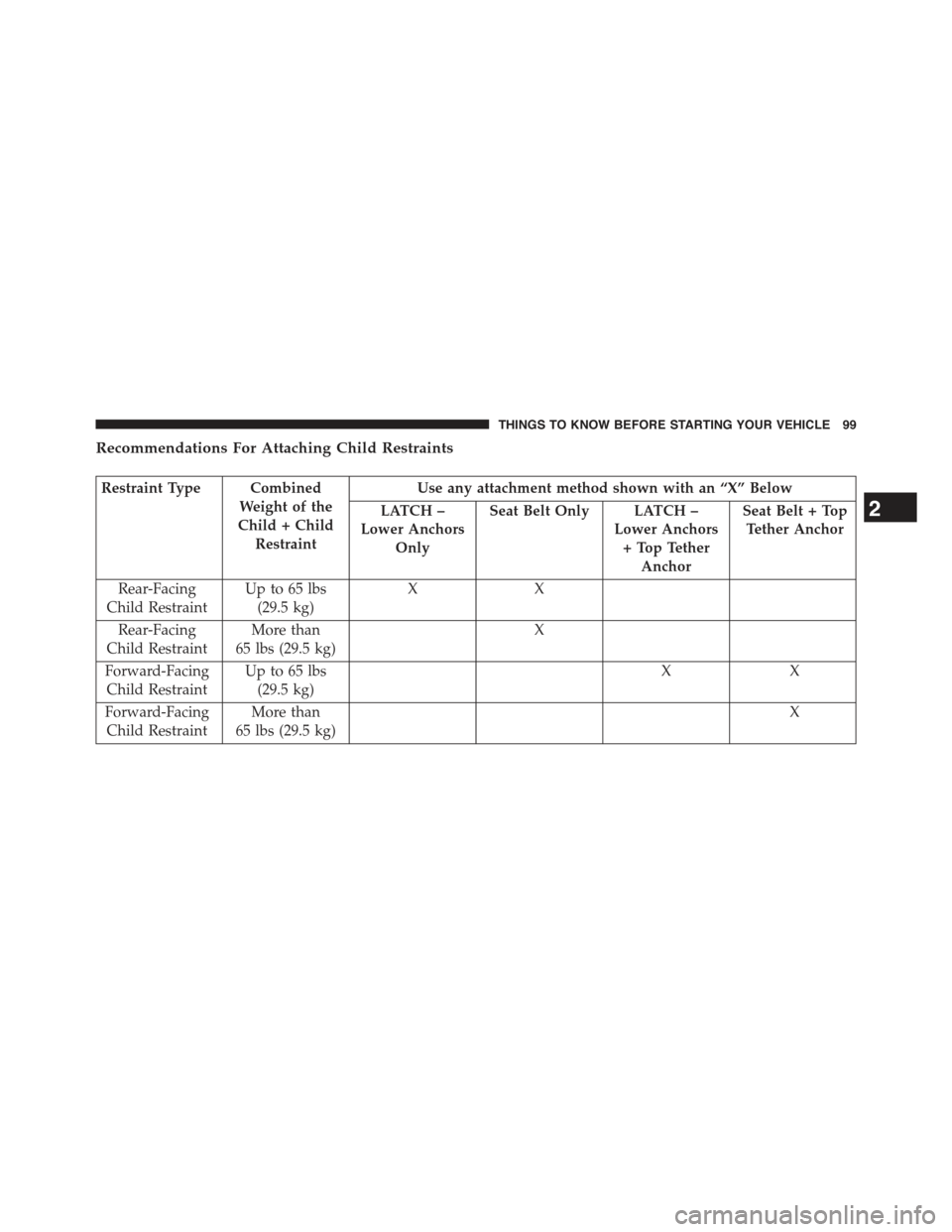
Recommendations For Attaching Child Restraints
Restraint Type Combined
Weight of the
Child + Child
Restraint
Use any attachment method shown with an “X” Below
LATCH –
Lower Anchors
Only
Seat Belt Only LATCH –
Lower Anchors
+ Top Tether
Anchor
Seat Belt + Top
Tether Anchor
Rear-Facing
Child Restraint
Up to 65 lbs
(29.5 kg)
XX
Rear-Facing
Child Restraint
More than
65 lbs (29.5 kg)
X
Forward-Facing
Child Restraint
Up to 65 lbs
(29.5 kg)
XX
Forward-Facing
Child Restraint
More than
65 lbs (29.5 kg)
X
2
THINGS TO KNOW BEFORE STARTING YOUR VEHICLE 99
Page 102 of 772
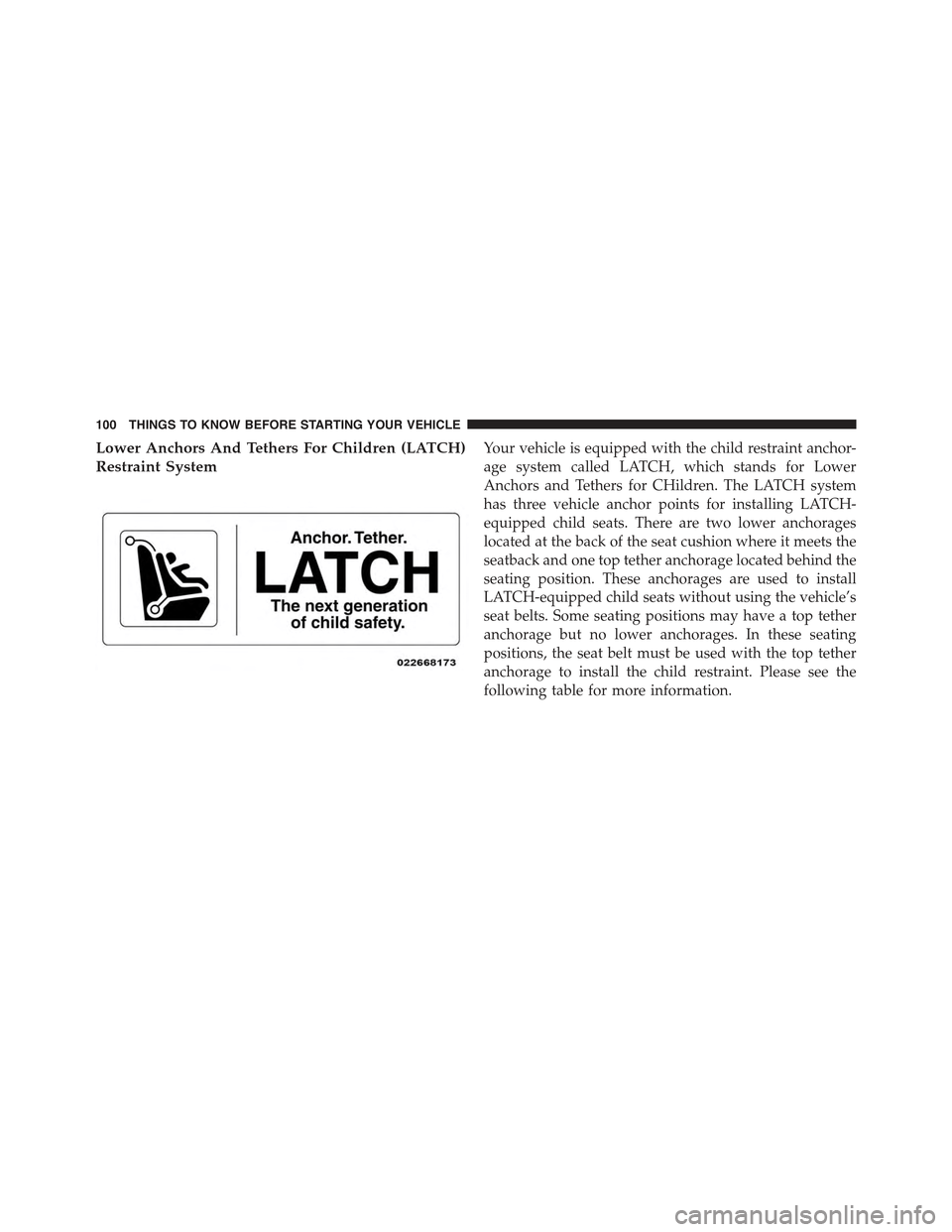
Lower Anchors And Tethers For Children (LATCH)
Restraint System
Your vehicle is equipped with the child restraint anchor-
age system called LATCH, which stands for Lower
Anchors and Tethers for CHildren. The LATCH system
has three vehicle anchor points for installing LATCH-
equipped child seats. There are two lower anchorages
located at the back of the seat cushion where it meets the
seatback and one top tether anchorage located behind the
seating position. These anchorages are used to install
LATCH-equipped child seats without using the vehicle’s
seat belts. Some seating positions may have a top tether
anchorage but no lower anchorages. In these seating
positions, the seat belt must be used with the top tether
anchorage to install the child restraint. Please see the
following table for more information.
100 THINGS TO KNOW BEFORE STARTING YOUR VEHICLE
Page 103 of 772
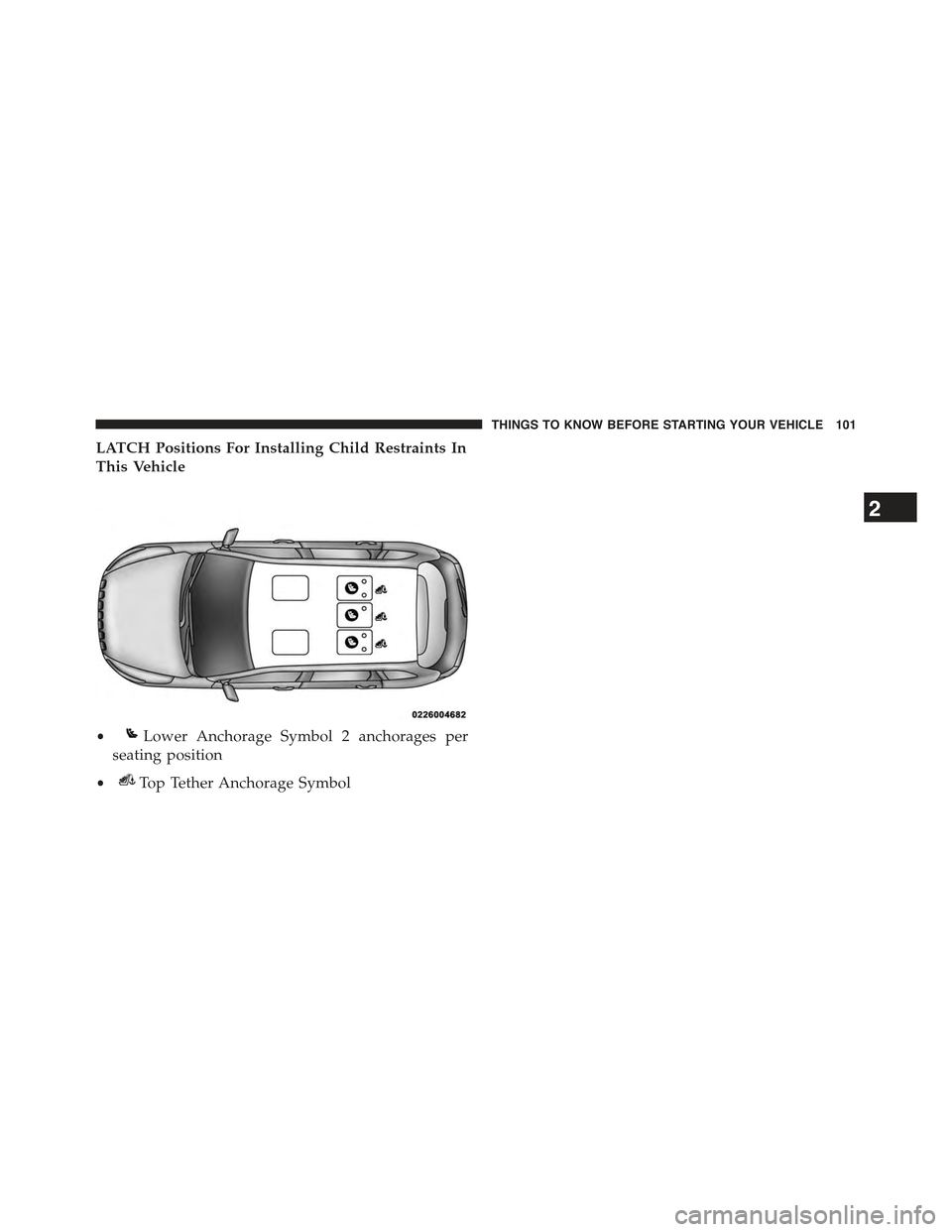
LATCH Positions For Installing Child Restraints In
This Vehicle
•Lower Anchorage Symbol 2 anchorages per
seating position
•Top Tether Anchorage Symbol
2
THINGS TO KNOW BEFORE STARTING YOUR VEHICLE 101
Page 104 of 772
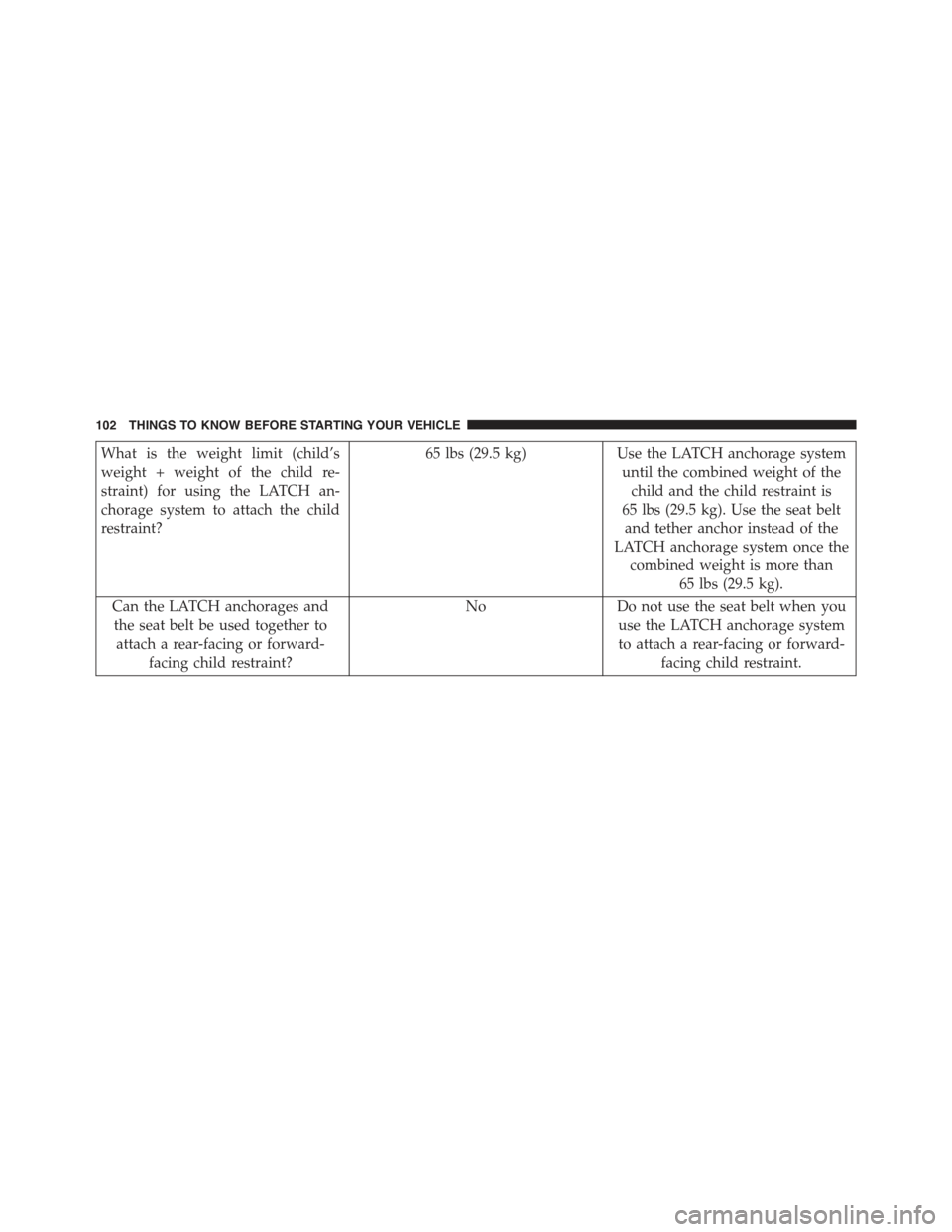
What is the weight limit (child’s
weight + weight of the child re-
straint) for using the LATCH an-
chorage system to attach the child
restraint?
65 lbs (29.5 kg) Use the LATCH anchorage system
until the combined weight of the
child and the child restraint is
65 lbs (29.5 kg). Use the seat belt
and tether anchor instead of the
LATCH anchorage system once the
combined weight is more than
65 lbs (29.5 kg).
Can the LATCH anchorages and
the seat belt be used together to
attach a rear-facing or forward-
facing child restraint?
No Do not use the seat belt when you
use the LATCH anchorage system
to attach a rear-facing or forward-
facing child restraint.
102 THINGS TO KNOW BEFORE STARTING YOUR VEHICLE
Page 105 of 772

Can two child restraints be at-
tached using a common lower
LATCH anchorage?
No Never “share” a LATCH anchorage
with two or more child restraints.
If the center position does not have
dedicated LATCH lower anchor-
ages, use the seat belt to install a
child seat in the center position
next to a child seat using the
LATCH anchorages in an outboard
position.
Can the rear-facing child restraint
touch the back of the front passen-
ger seat?
YesThe child seat may touch the back
of the front passenger seat if the
child restraint manufacturer also
allows contact. See your child re-
straint owner ’s manual for more
information.
Can the head restraints be re-
moved?
YesThe head restraints may be re-
moved in every rear seating posi-
tion.
2
THINGS TO KNOW BEFORE STARTING YOUR VEHICLE 103
Page 106 of 772
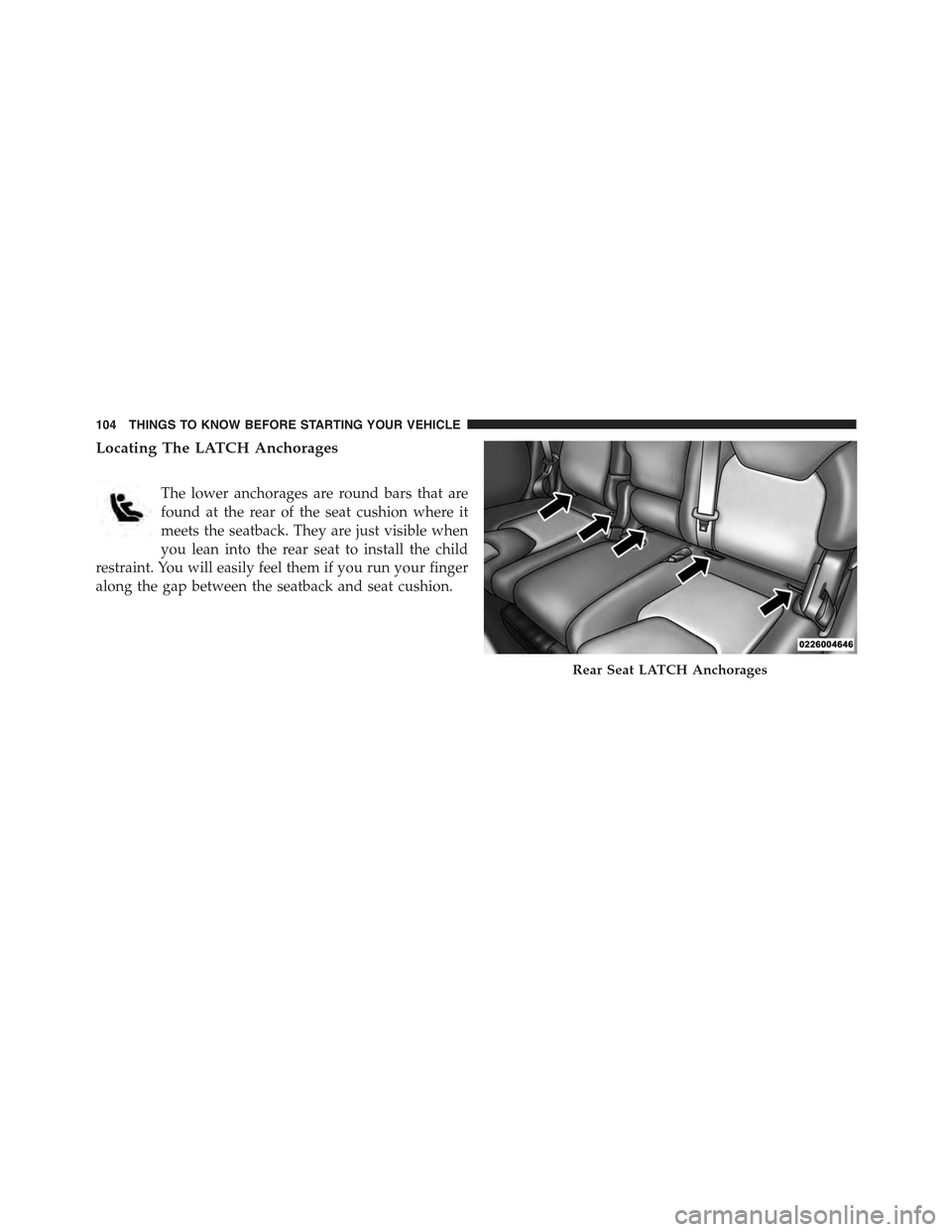
Locating The LATCH Anchorages
The lower anchorages are round bars that are
found at the rear of the seat cushion where it
meets the seatback. They are just visible when
you lean into the rear seat to install the child
restraint. You will easily feel them if you run your finger
along the gap between the seatback and seat cushion.
Rear Seat LATCH Anchorages
104 THINGS TO KNOW BEFORE STARTING YOUR VEHICLE
Page 107 of 772
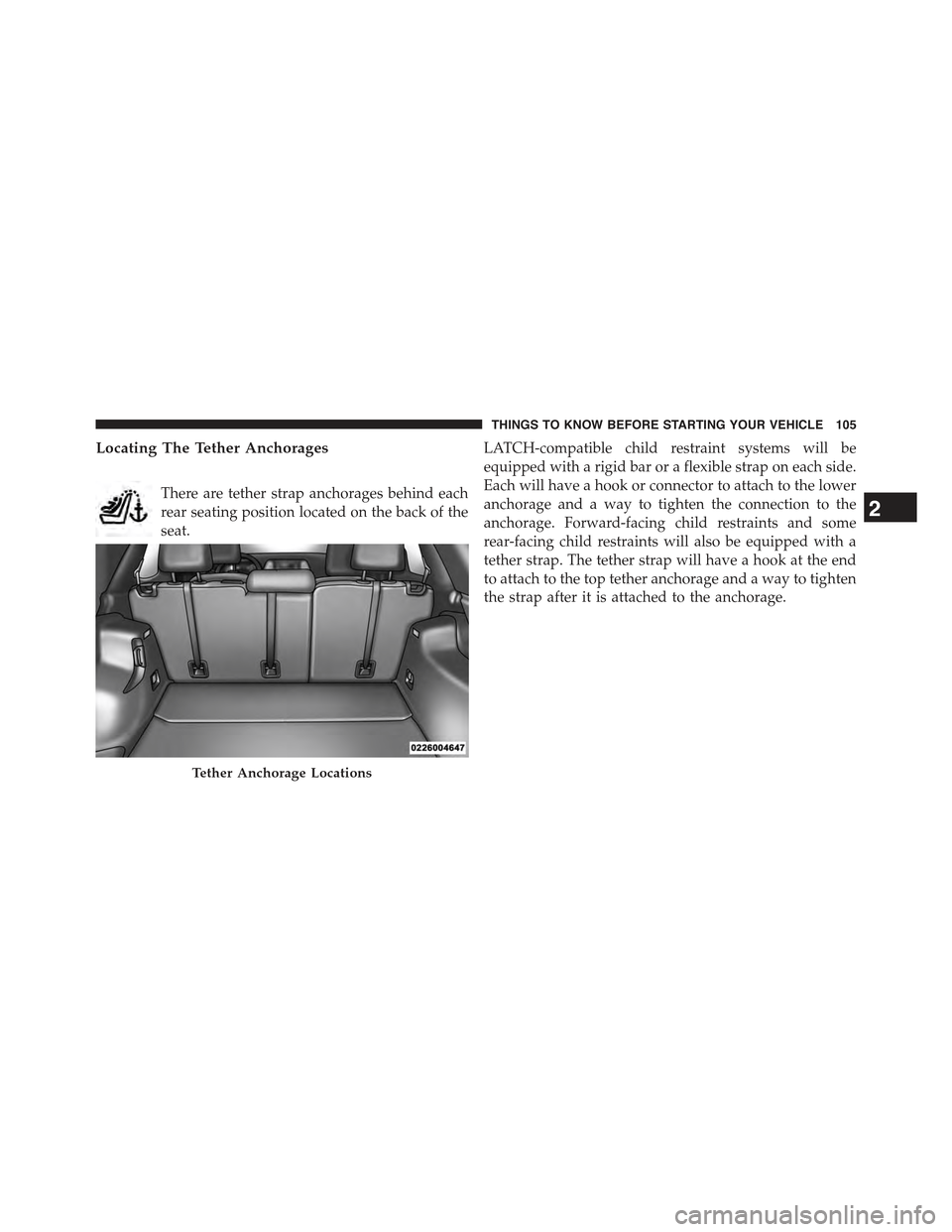
Locating The Tether Anchorages
There are tether strap anchorages behind each
rear seating position located on the back of the
seat.
LATCH-compatible child restraint systems will be
equipped with a rigid bar or a flexible strap on each side.
Each will have a hook or connector to attach to the lower
anchorage and a way to tighten the connection to the
anchorage. Forward-facing child restraints and some
rear-facing child restraints will also be equipped with a
tether strap. The tether strap will have a hook at the end
to attach to the top tether anchorage and a way to tighten
the strap after it is attached to the anchorage.
Tether Anchorage Locations
2
THINGS TO KNOW BEFORE STARTING YOUR VEHICLE 105
Page 108 of 772
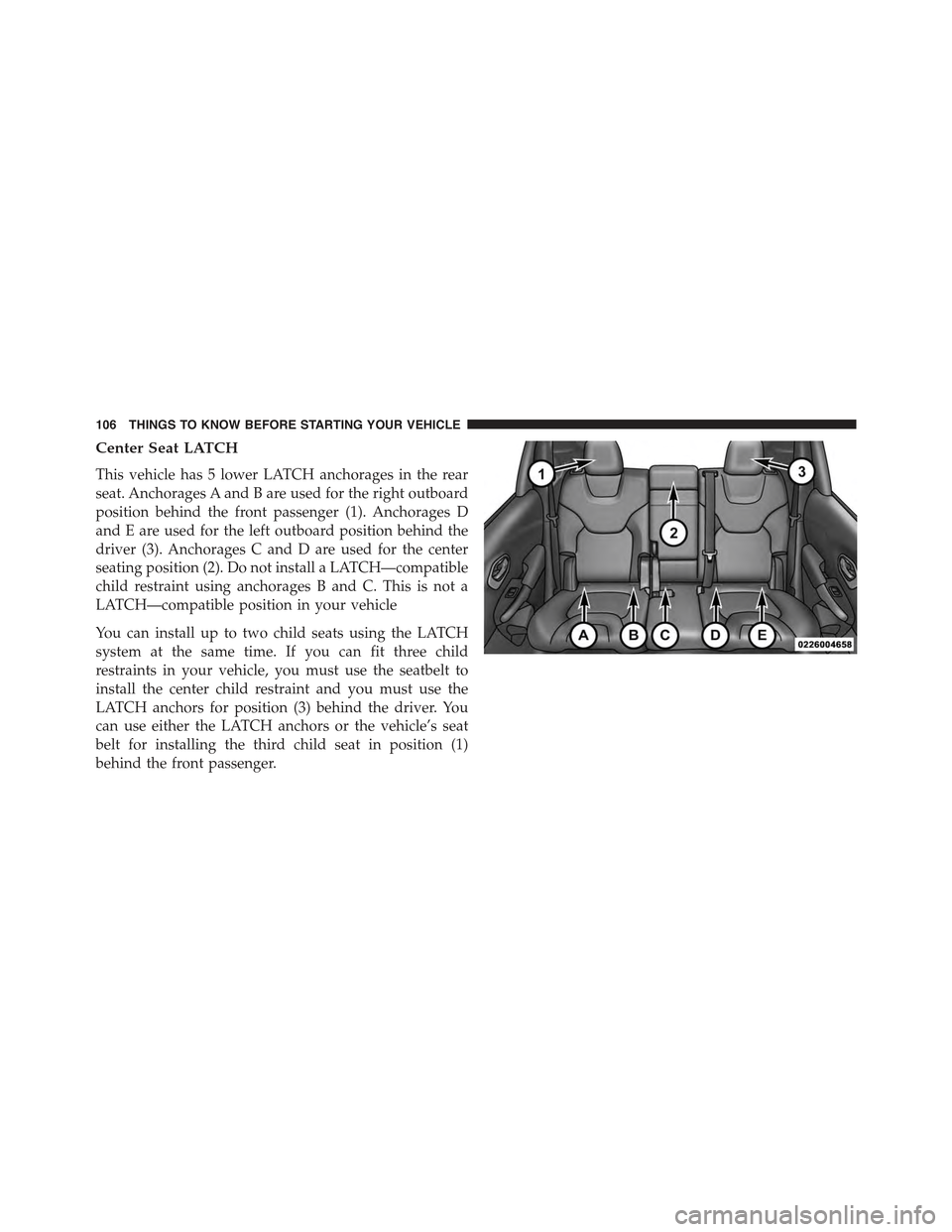
Center Seat LATCH
This vehicle has 5 lower LATCH anchorages in the rear
seat. Anchorages A and B are used for the right outboard
position behind the front passenger (1). Anchorages D
and E are used for the left outboard position behind the
driver (3). Anchorages C and D are used for the center
seating position (2). Do not install a LATCH—compatible
child restraint using anchorages B and C. This is not a
LATCH—compatible position in your vehicle
You can install up to two child seats using the LATCH
system at the same time. If you can fit three child
restraints in your vehicle, you must use the seatbelt to
install the center child restraint and you must use the
LATCH anchors for position (3) behind the driver. You
can use either the LATCH anchors or the vehicle’s seat
belt for installing the third child seat in position (1)
behind the front passenger.
106 THINGS TO KNOW BEFORE STARTING YOUR VEHICLE
Page 109 of 772
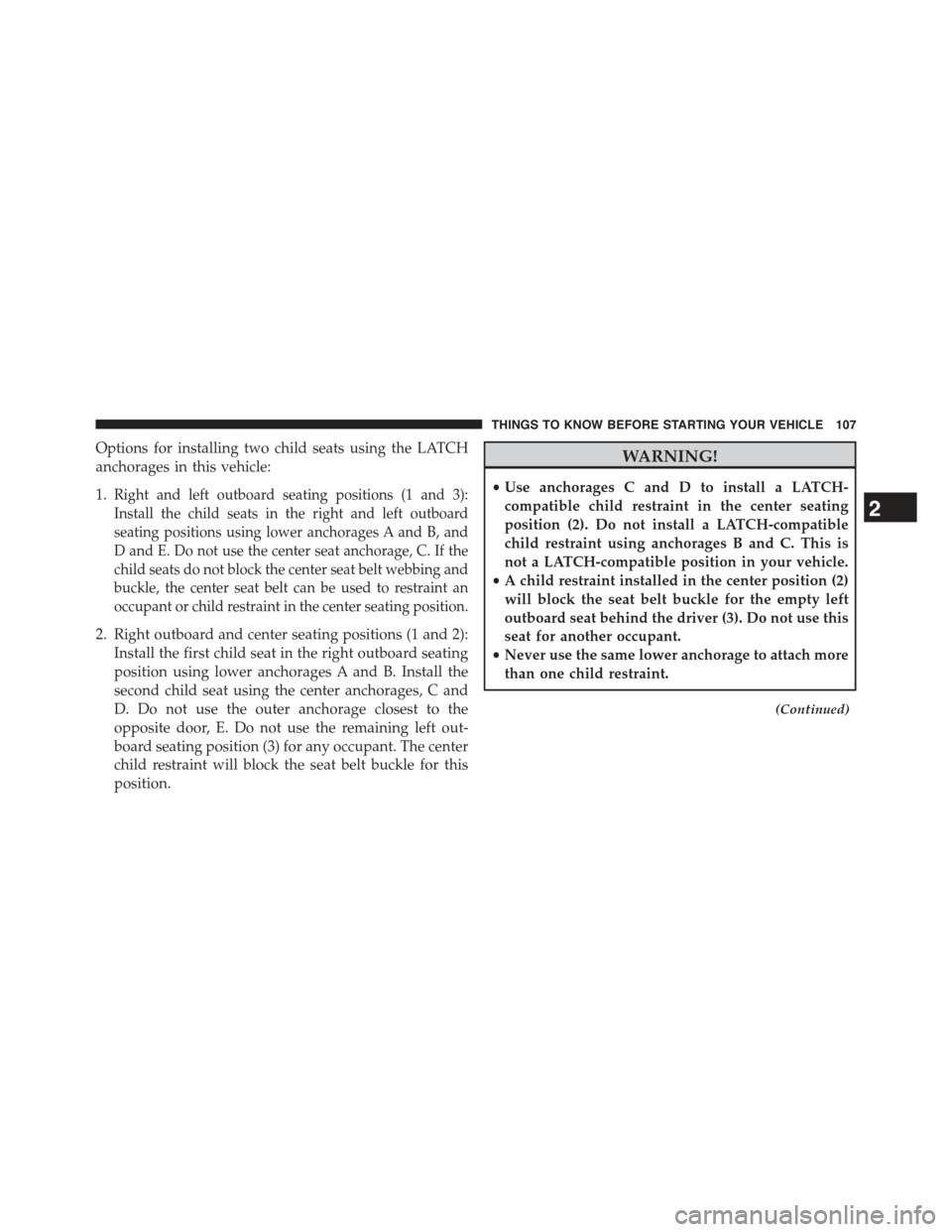
Options for installing two child seats using the LATCH
anchorages in this vehicle:
1.Right and left outboard seating positions (1 and 3):
Install the child seats in the right and left outboard
seating positions using lower anchorages A and B, and
D and E. Do not use the center seat anchorage, C. If the
child seats do not block the center seat belt webbing and
buckle, the center seat belt can be used to restraint an
occupant or child restraint in the center seating position.
2. Right outboard and center seating positions (1 and 2):
Install the first child seat in the right outboard seating
position using lower anchorages A and B. Install the
second child seat using the center anchorages, C and
D. Do not use the outer anchorage closest to the
opposite door, E. Do not use the remaining left out-
board seating position (3) for any occupant. The center
child restraint will block the seat belt buckle for this
position.
WARNING!
•Use anchorages C and D to install a LATCH-
compatible child restraint in the center seating
position (2). Do not install a LATCH-compatible
child restraint using anchorages B and C. This is
not a LATCH-compatible position in your vehicle.
•A child restraint installed in the center position (2)
will block the seat belt buckle for the empty left
outboard seat behind the driver (3). Do not use this
seat for another occupant.
•Never use the same lower anchorage to attach more
than one child restraint.
(Continued)
2
THINGS TO KNOW BEFORE STARTING YOUR VEHICLE 107
Page 110 of 772
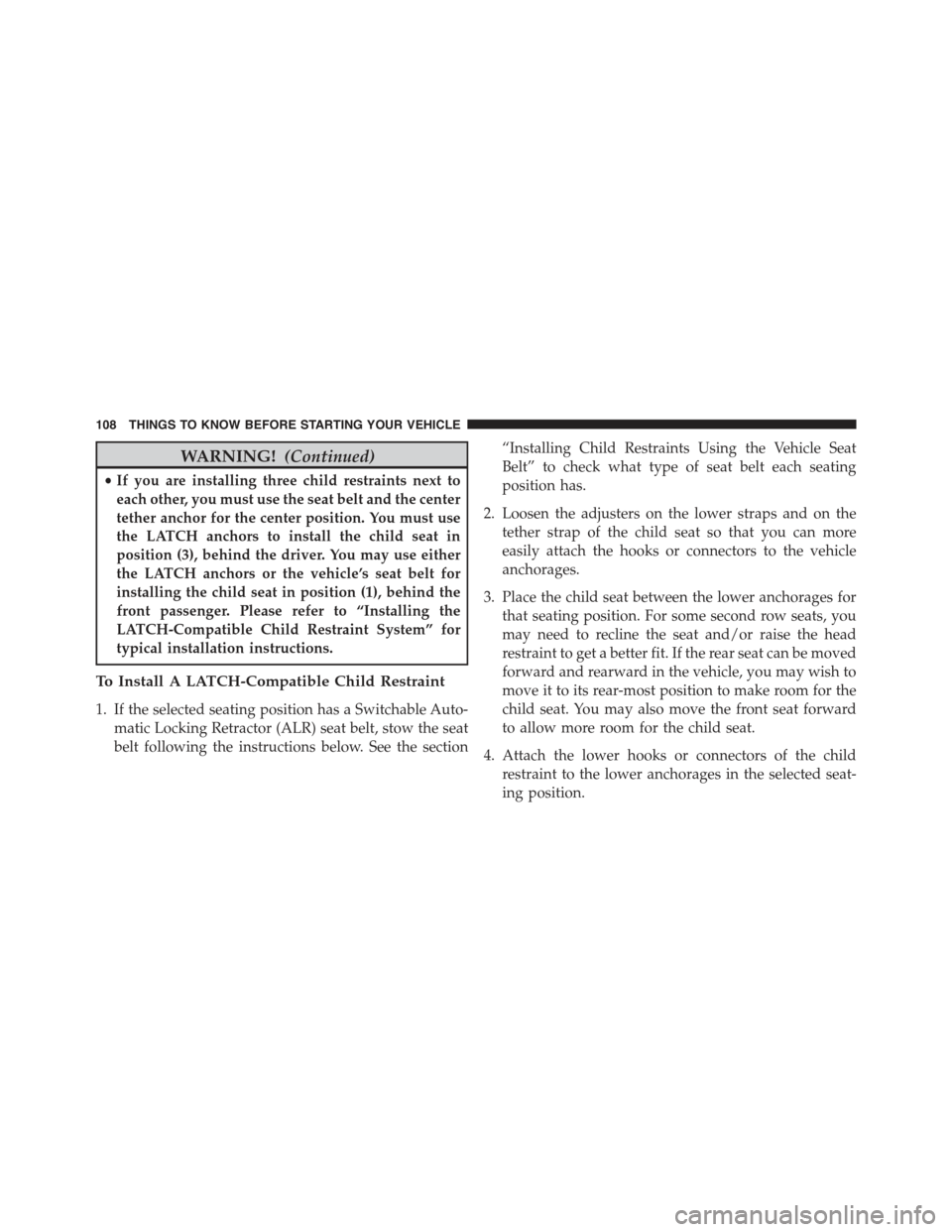
WARNING!(Continued)
•If you are installing three child restraints next to
each other, you must use the seat belt and the center
tether anchor for the center position. You must use
the LATCH anchors to install the child seat in
position (3), behind the driver. You may use either
the LATCH anchors or the vehicle’s seat belt for
installing the child seat in position (1), behind the
front passenger. Please refer to “Installing the
LATCH-Compatible Child Restraint System” for
typical installation instructions.
To Install A LATCH-Compatible Child Restraint
1. If the selected seating position has a Switchable Auto-
matic Locking Retractor (ALR) seat belt, stow the seat
belt following the instructions below. See the section
“Installing Child Restraints Using the Vehicle Seat
Belt” to check what type of seat belt each seating
position has.
2. Loosen the adjusters on the lower straps and on the
tether strap of the child seat so that you can more
easily attach the hooks or connectors to the vehicle
anchorages.
3. Place the child seat between the lower anchorages for
that seating position. For some second row seats, you
may need to recline the seat and/or raise the head
restraint to get a better fit. If the rear seat can be moved
forward and rearward in the vehicle, you may wish to
move it to its rear-most position to make room for the
child seat. You may also move the front seat forward
to allow more room for the child seat.
4. Attach the lower hooks or connectors of the child
restraint to the lower anchorages in the selected seat-
ing position.
108 THINGS TO KNOW BEFORE STARTING YOUR VEHICLE